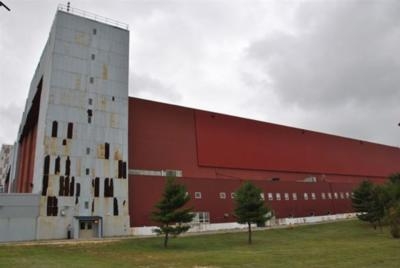Thu, Nov 06, 2014
Structures Originally Built To House Patrol Airships, Now Industrial Shops
The past has met the present at the historic lighter-than-air program district at Joint Base McGuire-Dix-Lakehurst in New Jersey.

Two historic hangars on base were fitted with solar walls last year, and the effort is saving the installation as much as $100,000 per year in utility costs. In addition to cost savings, the systems are expected to reduce greenhouse gas emissions by more than 470 metric tons per year -- the equivalent of taking about 100 passenger vehicles off the road.
Located adjacent to the site of the 1937 Hindenburg disaster, the hangars were originally built to house the patrol airships, or blimps, that accompanied supply ship convoys in support of the war effort in Europe during World War II. The blimps played a crucial role in anti-submarine warfare conducted by the allies against German U-boats. Since the mid-1970s, the hangers have been used by the Navy as industrial shops for the production of launching and arresting gear components for aircraft carriers.
To help meet the installation's energy reduction goals and reduce natural gas heating costs, energy experts with the 87th Civil Engineer Squadron researched energy-saving options for the hangars, and ultimately chose to install solar walls.
"These facilities were large natural gas users in the winter," said Chun Eng, the base energy manager. "They also both have a southern exposed wall, with no windows or offices behind the walls which made it easier for installation."
The walls work by using the sun to heat the building's ventilation air, thereby reducing dependence on other energy sources for heating purposes, Eng said. The systems, which will pay for themselves in less than eight years, are relatively maintenance-free and projected to last 30 years or more.
While the benefits can be substantial, fitting historic buildings with solar walls can be challenging, as the additions cannot detract from the historic character of the facility, said John Joyce, the base natural and cultural resources manager.
"The biggest challenge is visual," Joyce said. "If you can't get the panels to blend, they kind of stick out like a sore thumb. Who goes by a roof full of solar panels and doesn't notice that it's a roof full of solar panels?"
To overcome this issue, the installation's cultural resource and energy team worked closely with the New Jersey Historic Preservation Office to design panels that blend almost perfectly with the existing exterior hangar walls.
The project proves that protecting the past doesn't have to infringe on the future, Joyce said.
"We had what amounted to two potentially competing goals -- historic preservation and energy conservation," Joyce said. "Like a lot of other things you do in life, it's a balancing act. A project like this one proves it can be done to satisfy both requirements. It does take effort, but in the long run, this project will save money and yet it doesn't really infringe on the historic character of the building. It was a win-win in this case."
(USAF image)
More News
Airport Rotating Beacon A visual NAVAID operated at many airports. At civil airports, alternating white and green flashes indicate the location of the airport. At military airports>[...]
Aero Linx: Fly for the Culture Fly For the Culture, Inc. is a 501(c)(3) non-profit organization that serves young people interested in pursuing professions in the aviation industry>[...]
Klyde Is Having Some Issues Comprehending The Fed's Priorities FMI: www.klydemorris.com>[...]
Also: Viasat-uAvionix, UL94 Fuel Investigation, AF Materiel Command, NTSB Safety Alert Norges Luftsportforbund chose Aura Aero's little 2-seater in electric trim for their next gli>[...]
Also: EP Systems' Battery, Boeing SAF, Repeat TBM 960 Order, Japan Coast Guard H225 Buy Despite nearly 100 complaints totaling millions of dollars of potential fraud, combined with>[...]
 ANN's Daily Aero-Term (04.25.24): Airport Rotating Beacon
ANN's Daily Aero-Term (04.25.24): Airport Rotating Beacon ANN's Daily Aero-Linx (04.25.24)
ANN's Daily Aero-Linx (04.25.24) Klyde Morris (04.22.24)
Klyde Morris (04.22.24) Airborne 04.24.24: INTEGRAL E, Elixir USA, M700 RVSM
Airborne 04.24.24: INTEGRAL E, Elixir USA, M700 RVSM Airborne 04.22.24: Rotor X Worsens, Airport Fees 4 FNB?, USMC Drone Pilot
Airborne 04.22.24: Rotor X Worsens, Airport Fees 4 FNB?, USMC Drone Pilot



